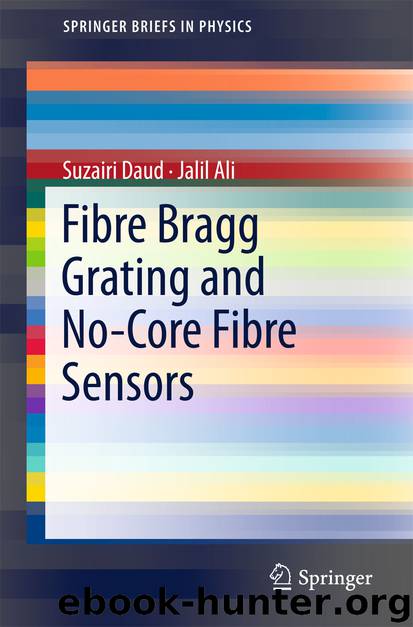Fibre Bragg Grating and No-Core Fibre Sensors by Suzairi Daud & Jalil Ali

Author:Suzairi Daud & Jalil Ali
Language: eng
Format: epub
Publisher: Springer International Publishing, Cham
3.6 Fabrication of Fibre Bragg Grating
The fabrication of FBG is formed by KrF excimer laser (248 nm wavelength ), mask aligner, TLS, and OSA. TLS provides a light source which passes through the optical fibre while OSA plays a critical role in demodulation to detect the growth of fibre grating and obtain the relevant spectrum . The schematic diagram for the fabrication of FBG is shown in Fig. 3.7.
Fig. 3.7Schematic diagram of FBG fabrication setup
The jacket or cladding of the section where the grating is supposed to be written should be removed before the fibre is placed on the platforms. For a QPS fibre, which has a standard diameter of 125 μm, the fibre jacket should be removed by a cleaver or stripper. For other types of fibres, a mixture of 50% dichloromethane and 50% acetone could be used for the purpose. Alternatively, one could use Nitromors (a paint stripper) but it will take a longer time. For certain jacket materials, the percentage of dichloromethane and acetone in the mixture would need to be changed. When the fibre is placed on the platform, a slight strain could be applied to ensure that the fibre is straight. It is also noteworthy that the naked photosensitive fibre should be cleaned thoroughly with acetone or alcohol before placing it on the platforms, otherwise the UV beam can ablate any remaining jacket and might damage the phase mask.
The fibre is connected to the OSA and TLS. The real-time growth of the FBG is monitored with the OSA. It is necessary to clean all the optical elements in the mask aligner (reflecting mirror, cylindrical lens, phase mask, and quartz plate) with compressed nitrogen gas because any dust could absorb UV light and thus reduce the efficiency of the process. To ensure that the energy status of the excimer laser is suitable, several laser pulses with energy between 100 and 130 mJ at 20–30 kV voltage supply are tested in a closed tube. If the excimer laser output drops below the operation range, a new gas fill would be needed. After every new fill, a fine tune on the optical alignment of the laser pulses would be required.
With the completion of the optical alignment, the excimer laser is tuned to the pulsed mode. A suitable number of pulses are inserted to the laser controller and the grating writing process is started. The laser beam from the excimer laser enters the mask aligner and hits the fibre via the phase mask after passing through some mirrors and lens. The growth of the grating in terms of the center wavelength and reflectivity is monitored using OSA and the UV light that passes through the cylindrical lens is focused linearly onto the fibre core . To monitor the growth of the grating in transmission with a stopwatch, the light from the TLS is launched into the core of this fibre at one end and monitored with the OSA at the other end. The writing process is then stopped when the desired characteristics of the grating are achieved.
Download
This site does not store any files on its server. We only index and link to content provided by other sites. Please contact the content providers to delete copyright contents if any and email us, we'll remove relevant links or contents immediately.
| Automotive | Engineering |
| Transportation |
Whiskies Galore by Ian Buxton(41879)
Introduction to Aircraft Design (Cambridge Aerospace Series) by John P. Fielding(33064)
Small Unmanned Fixed-wing Aircraft Design by Andrew J. Keane Andras Sobester James P. Scanlan & András Sóbester & James P. Scanlan(32743)
Craft Beer for the Homebrewer by Michael Agnew(18140)
Turbulence by E. J. Noyes(7935)
The Complete Stick Figure Physics Tutorials by Allen Sarah(7307)
Kaplan MCAT General Chemistry Review by Kaplan(6866)
The Thirst by Nesbo Jo(6826)
Bad Blood by John Carreyrou(6552)
Modelling of Convective Heat and Mass Transfer in Rotating Flows by Igor V. Shevchuk(6391)
Learning SQL by Alan Beaulieu(6209)
Weapons of Math Destruction by Cathy O'Neil(6142)
Man-made Catastrophes and Risk Information Concealment by Dmitry Chernov & Didier Sornette(5921)
Digital Minimalism by Cal Newport;(5663)
Life 3.0: Being Human in the Age of Artificial Intelligence by Tegmark Max(5474)
iGen by Jean M. Twenge(5366)
Secrets of Antigravity Propulsion: Tesla, UFOs, and Classified Aerospace Technology by Ph.D. Paul A. Laviolette(5309)
Design of Trajectory Optimization Approach for Space Maneuver Vehicle Skip Entry Problems by Runqi Chai & Al Savvaris & Antonios Tsourdos & Senchun Chai(5011)
Pale Blue Dot by Carl Sagan(4912)
